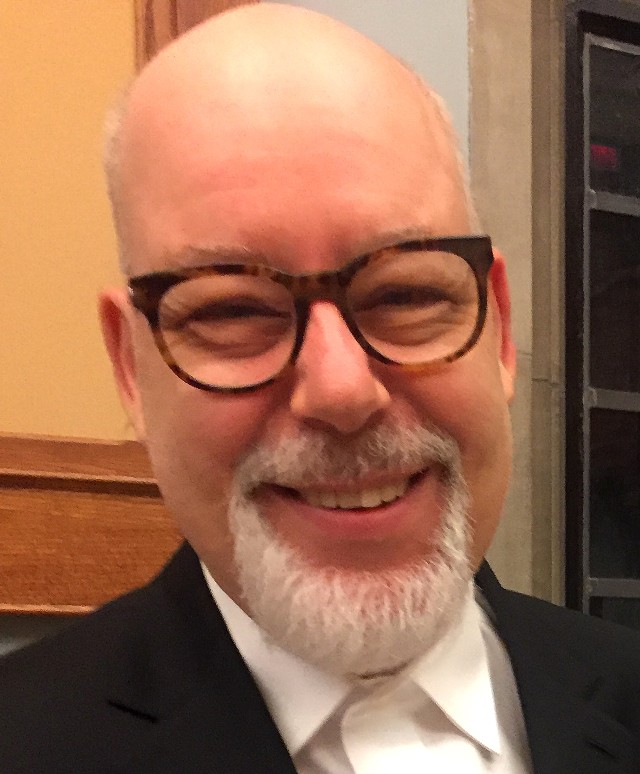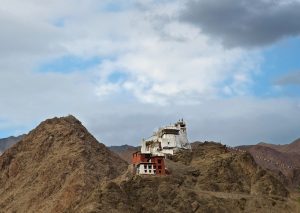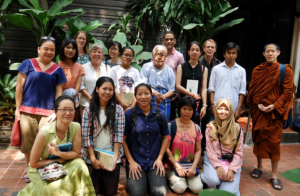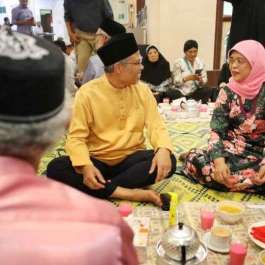
Shambhala comprises 140 city centers and seven land centers worldwide, which makes them the largest organizational network of any Western Buddhist lineage. The lineage has experienced many challenges since Chögyam Trungpa came to America in 1970, including the fallout from widespread dysfunctional behavior and sexual abuse by community leaders over a long time, and external pressures such as the social and economic impact of COVID-19. However, through all of this, the greater community’s commitment to ecoDharma, known as the Touching the Earth Collective, has flourished.
The first thing to do when looking at the Shambhala Touching the Earth Collective (STEC) is to let go of assumptions about who they are and what they do. Then one can really come to appreciate their amazing work and wider impact.
STEC grew out of a series of Shambala Earth Salons between 2016 and 2018, and was formally born in 2018. David Takahashi, who later became the Shambhala ecoDharma doula, was one of the founders. Another of the founders, Irene Woodard, is a GreenFaith Fellow and currently serves as vice-chair of GreenFaith’s board of directors.
I had the opportunity to talk and correspond with them about STEC earlier this year.
How is your network structured?
A recurring theme in my conversations with David and Irene was about how the collective is structured. I was looking for synergies and projects that could only be undertaken by such a large and diverse organization, as opposed to a single Dharma center. David and Irene referred repeatedly to the example of the world’s largest organism, the Pando Grove.
According to Wikipedia, Pando (Latin for “I spread out”), also known as the “Trembling Giant” is a clonal colony of an individual male quaking aspen (Populus tremuloides) that had been determined to be a single living organism by identical genetic markers and assumed to have one massive underground root system. The plant is located in the Fremont River Ranger District of the Fishlake National Forest at the western edge of the Colorado Plateau in south-central Utah, around 1.6 kilometers southwest of Fish Lake. Pando occupies 43 hectares and is estimated to weigh collectively six million kilograms, making it the heaviest known organism. The root system of Pando, estimated to be 80,000 years old, is among the oldest known living organisms.
The point here is that STEC has no central authority. Each center responds to its local environment. Everybody contributes and everybody benefits. That is interbeing in action! Put another way, their achievements are crowdsourced. It’s a bottom-up approach rather than top-down. It’s also an approach that is rare in Western Buddhist centers, which often present a more autocratic organizational structure. Perhaps the collective grassroots approach also serves to avoid some of the problems the lineage has experienced in the past from top-down leadership.
Since its inception, the collective has been recognized by Shambhala Global Services as a vital entity in the organization and so holds a seat as a member of the executive staff of Shambhala, with a voice that is shared into the global Shambhala organization, both in meetings and throughout the network of shared activities. They have also received funding from the Bess Family Foundation and the Lenz Family Foundation, as well as partnering with those organizations on related initiatives.
What does the collective do in the Shambhala mandala?
The STEC website contains a broad array of ecoDharma content, such as:
- • An archive of more than 40 newsletters dating back to 2020, filled with great articles, event reports, programs, book and movie reviews, links, and much more;
- • A video archive of more than 30 Earth Salon online gatherings on a wide variety of topics relating to ecology, regenerative design, and sustainable society from a Buddhist perspective—also available on Vimeo; and
- • EcoDharma liturgy and ritual resources.
The collective has also run two public symposia on climate change, contributed to three Warrior Assemblies, including nature connection as a take-home practice, introduced Bokashi (fermented) composting at the Colorado Assembly, and promoted elimination of single-use plastics and a variety of other carbon footprint/pollution reduction initiatives at centers and gatherings worldwide. There are also active STEC Google and Facebook groups.

How does the collective work with secular environmental organizations in the larger world?
The range of outreach projects from STEC is also extensive.
As part of their Elemental Expression initiative, the collective has been doing major wildfire mitigation projects at their dedicated solitary retreat center in Colorado, Dorje Khyung Dzong, and their Northern Colorado Land Center, Drala Mountain, which was burned by a major wildfire. The state has recognized that their land practices at that latter center retarded the fire and avoided down-wind damage to others. Part of the fire remediation involves wetland revival, with the target of re-introducing beavers. In addition to working with GreenFaith and the State of Colorado, STEC has worked with fire districts, local governments, and local universities. Drala Mountain Center has trained front-line firefighters in contemplative practice.
Here is a partial list of other work by David Takahashi, the group’s ecoDharma doula, in collaboration with secular organizations:
- • Partnered with the City of Boulder on a project called “Greening Houses of Worship”;
- • Organized an Interfaith Greening Conference with Together Colorado and Creation Care Network;
- • Participated in the Marshall Fire Rebuild Long-Term Recovery planning team;
- • Served as a Bess Foundation EcoAdvisor; and
- • Served as a Lenz Foundation “Future of Buddhism” grantee for research on Indigenous-based American Buddhism.
And here is a partial list of interfaith environmental work by Irene Woodard, in addition to her work managing the GreenFaith organization—“always wearing my mala and Shambhala pin,” Irene notes that she:
- • Shared in multiple actions with Greenpeace, XR, Third Act, and Beyond Plastics;
- • Attended two COP Summits, marched in Firedrill;
- • Led a Greenfaith and Shambhala team to Standing Rock.
What challenges have you faced?
The double whammy of the COVID-19 shutdown and subsequent global economic tightening, on top of the community split due to allegations of the misuse of power, has left many Shambhala city centers struggling to exist. Some have been forced to close their brick-and-mortar versions. Those that remain open have been able to do so largely because of that Pando connective tissue.
While there is motivation and real curiosity to evolve as a society, as a community that cares for and protects the Earth, Shambhala is only at the beginning of seeing their buildings go green—finances fall short.
In response to those challenges, the organization has used its online teaching platform, Shambhala Online, to create a shared revenue model that allows underserved and marginally located centers to offer training from their world-class teaching faculty to outlying centers with a 50/50 revenue split. Touching the Earth initiatives are available to practitioners there as well as in other ways.
The old organizational structure for synergistic networking and intercommunity relationships relied on air travel. In 2020, during the COVID-19 lockdowns, STEC proposed a new paradigm, Dharma Programs Without Jet Fuel. Now, that vision has been realized, with virtual and hybrid programming that comes with a much lower cost to participants and the environment, and keeping community bonds strong.
What’s in the next chapter?
“We need more curriculum,” is an oft-repeated request from centers in the collective. To that end, David is writing a book to give rural Buddhist centers the tools to “walk the talk” of responsible stewardship. Irene and a small team are in the planning stages of organizing and presenting new Shambhala ecoDharma resources.
The collective is also in the planning stages for a new series of talks and events. The community is asking them to take the lead, create portals, and make commitments to making our world less greedy, less polluted, more mindful, and more creative.
A first in-person/hybrid event is in the works, says Irene, to build on requests from the Shambhala Society to “establish creative and rigorous actions for those in the mandala that want to manifest the mission of engaging warriors to uphold the healthy sustainability of the sacred living environment for all beings.”
May it be auspicious!
See more
Shambhala Touching the Earth Collective
Earth Salon (Vimeo)
Shambhala Online
Related features from BDG
A Conversation with Tim Ream, EcoDharma Teacher
The Barre Center for Buddhist Studies: EcoDharma Beacon
Touching the Earth: An Ecodharma Retreat
How Buddhists Can Embrace the Degrowth Movement
Related news reports from BDG
Colorado’s Drala Mountain Center (Formerly Shambhala Mountain Center) Files for Bankruptcy
Shambhala USA at Heart of Vermont Supreme Court Case Extending Abuse Survivor Rights
Colorado’s Shambhala Mountain Center Announces Self Governance and Other Updates
Shambhala Mountain Center in Colorado Loses Buildings to Wildfire
Shambhala Transition Task Force Announces its Dissolution
Police Launch Investigation into “Possible Criminal Activity” at Shambhala Mountain Center












